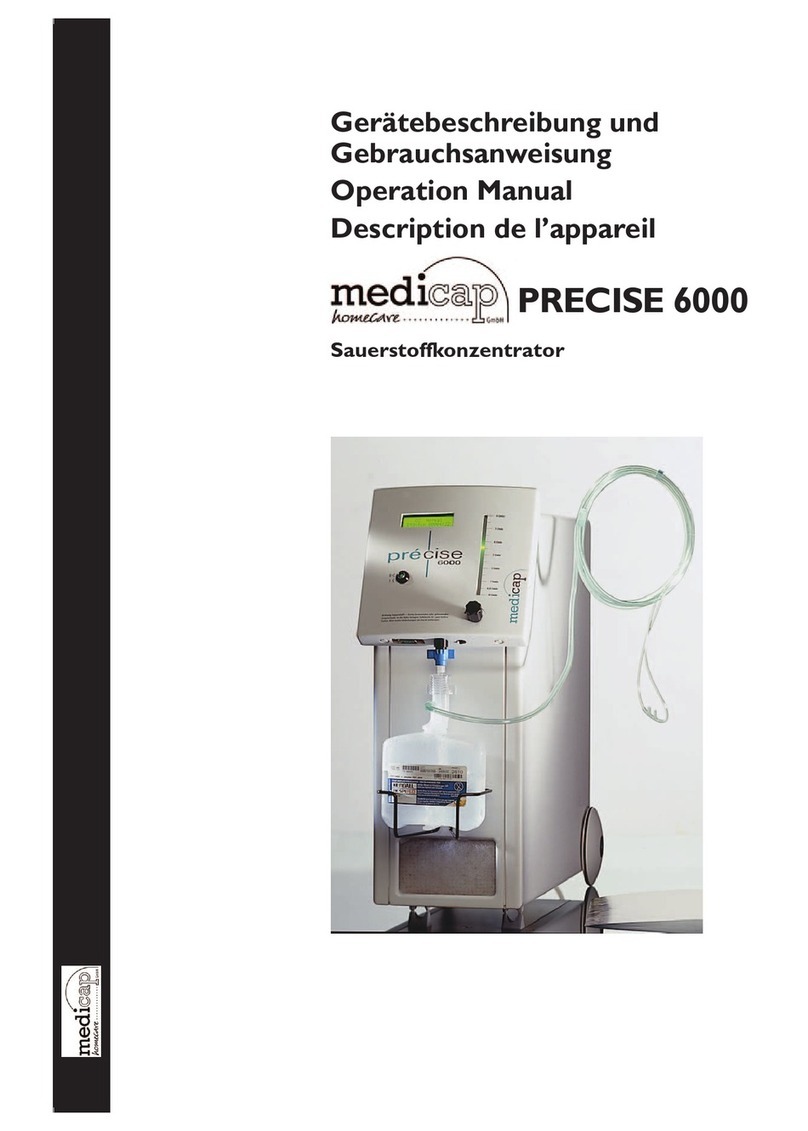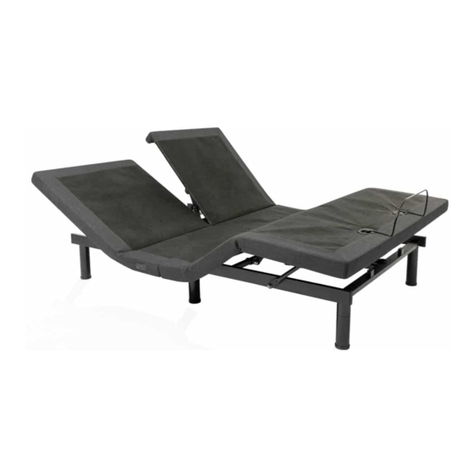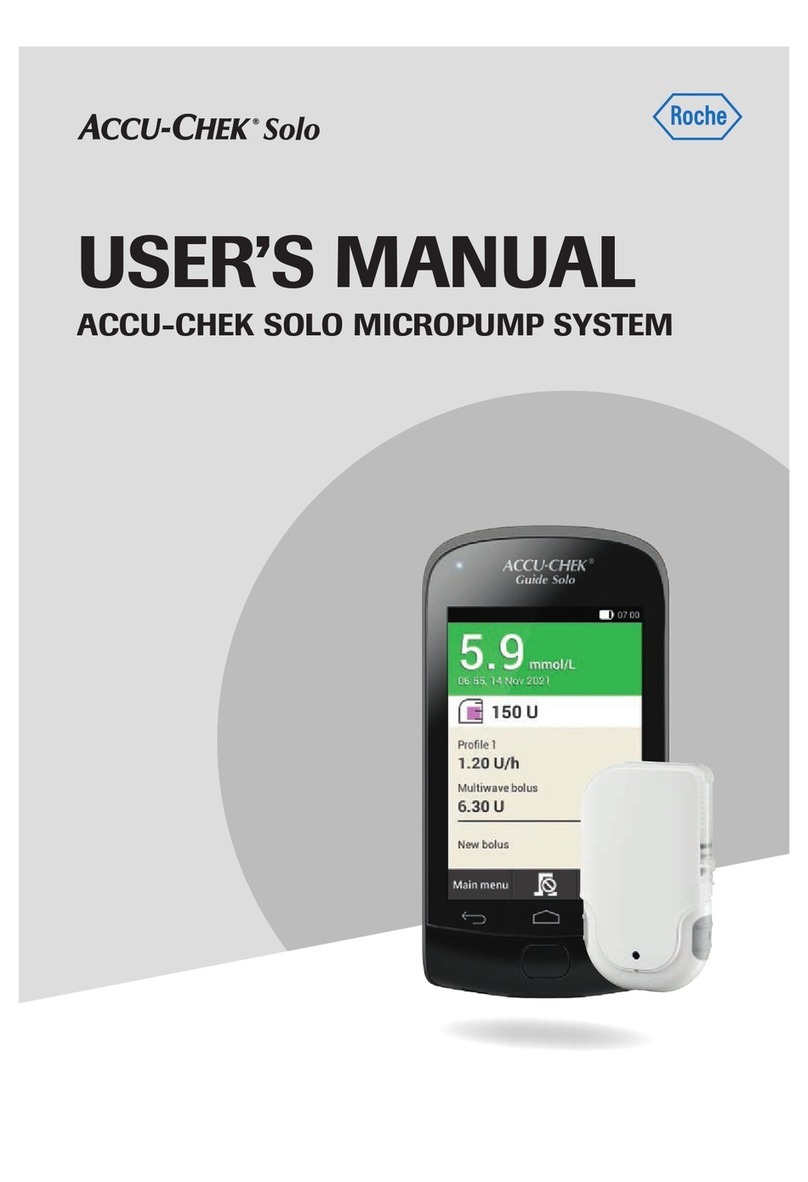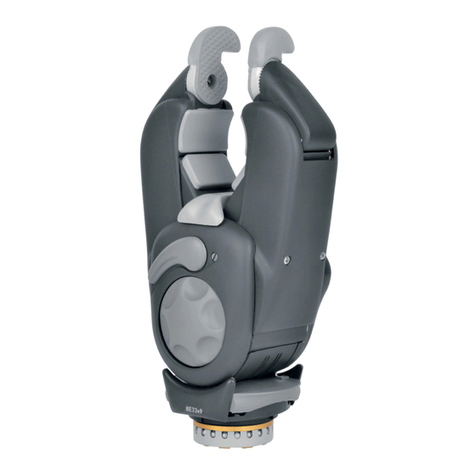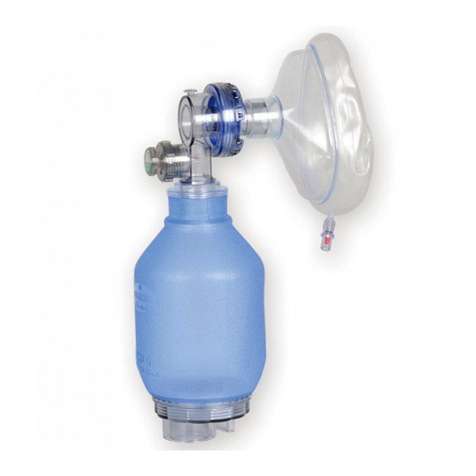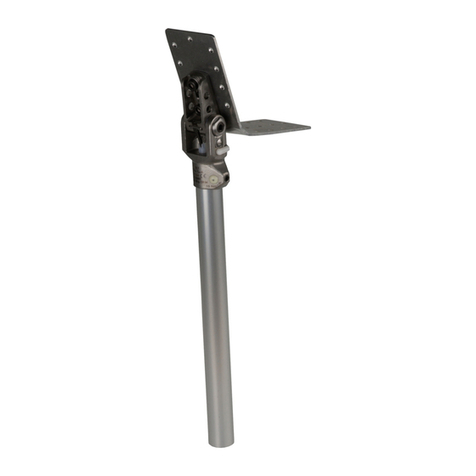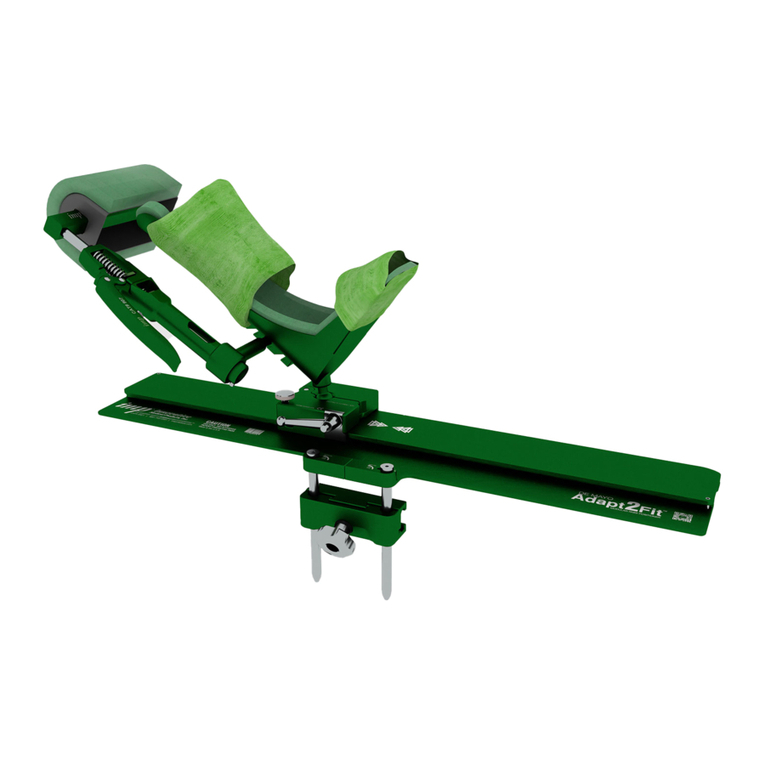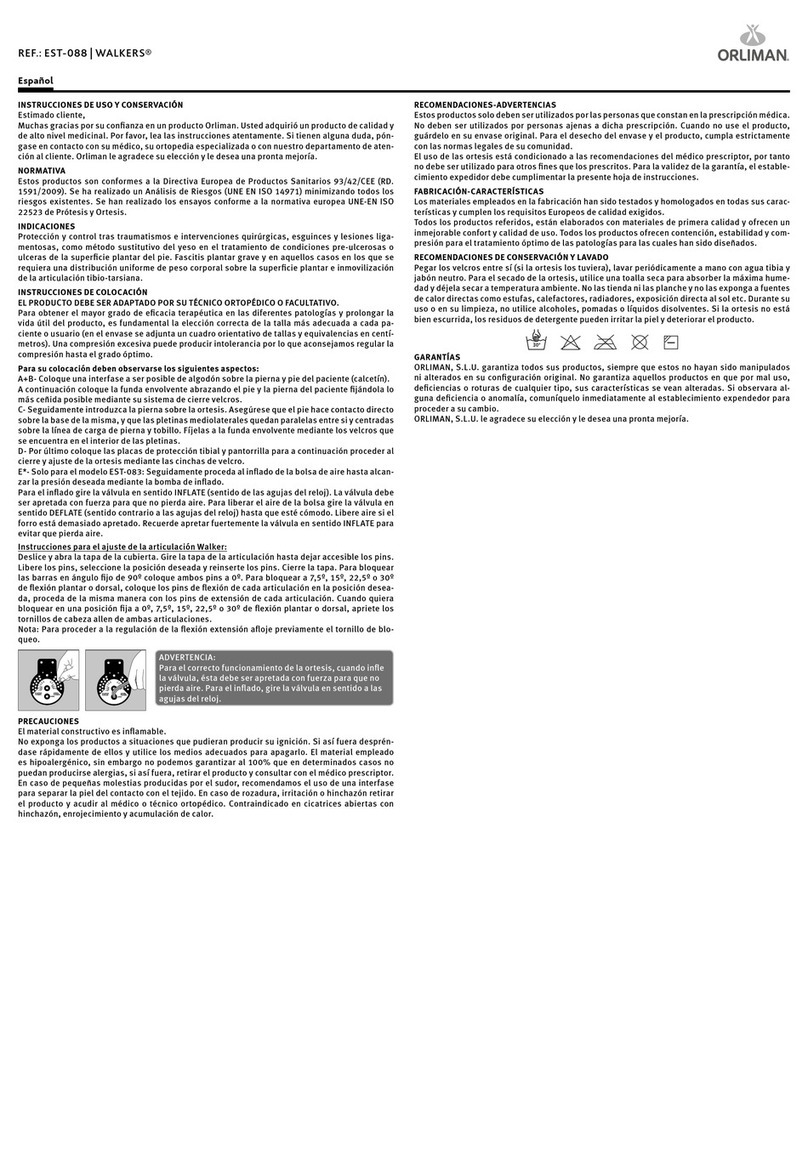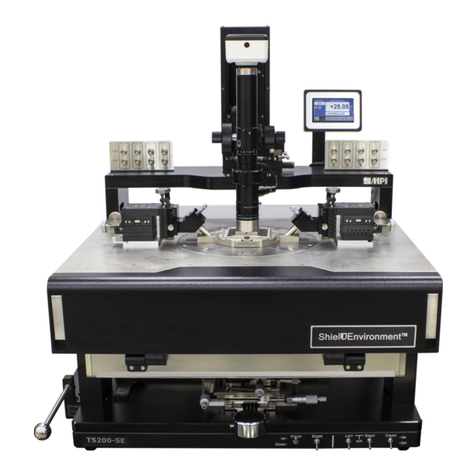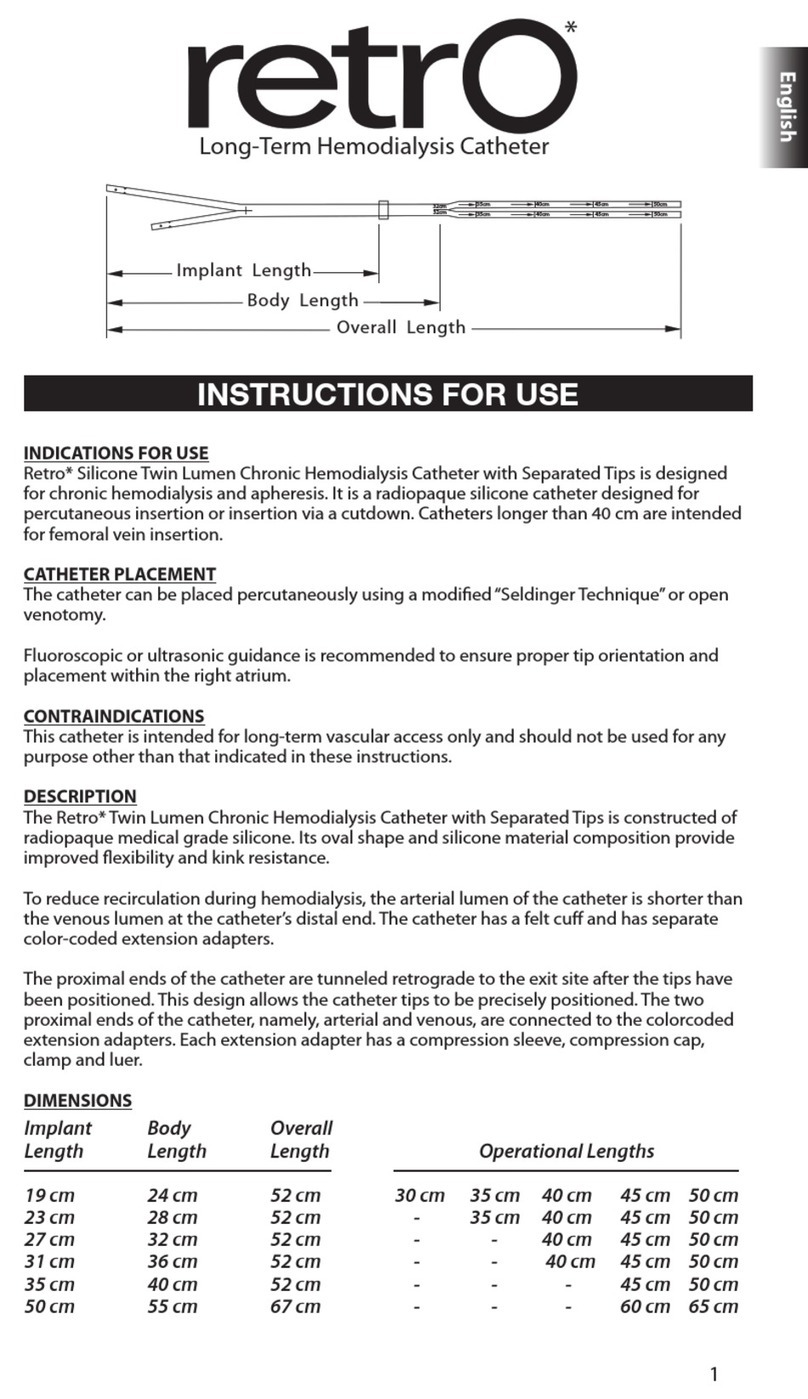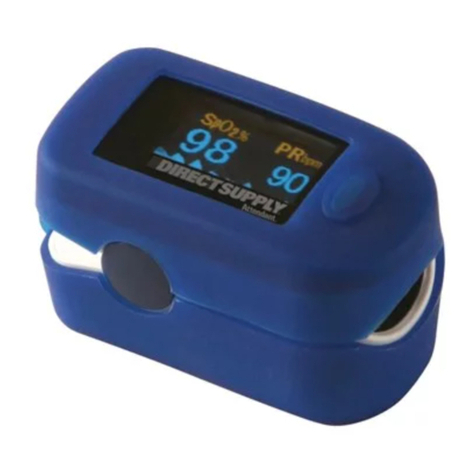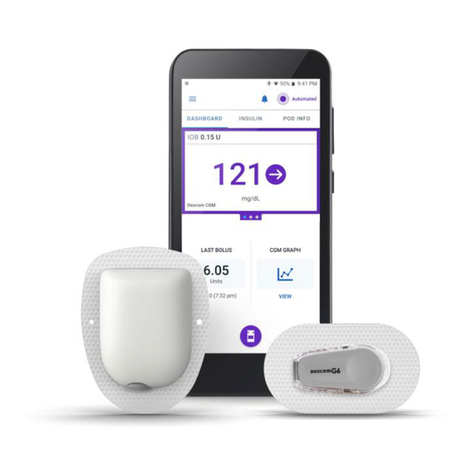Medicap PRECISE 3000 User manual

Gerätebeschreibung und
Gebrauchsanweisung
Operation Manual
Description de l’appareil
Technische handleidingen,
Gebruiksinstructies
PRECISE 3000
Elektronisches Gassparsystem

2
Inhaltsverzeichnis
Inhalt . . . . . . . . . . . . . . . . . . . . . . . . . . . . . . . . . . . . . . . . . . . . . . . . . . . . . . . . . . . . . . . Seite
1. Allgemeines und Sicherheitshinweise . . . . . . . . . . . . . . . . . . . . . . . . . . . . . . . . . . . . . . 13
1.1 Verwendungszweck . . . . . . . . . . . . . . . . . . . . . . . . . . . . . . . . . . . . . . . . . . . . . . . . . . . . . 13
1.2. Funktionsbeschreibung . . . . . . . . . . . . . . . . . . . . . . . . . . . . . . . . . . . . . . . . . . . . . . . . . . 14
1.3. Sicherheitshinweise . . . . . . . . . . . . . . . . . . . . . . . . . . . . . . . . . . . . . . . . . . . . . . . . . . . . . 14
2. Anwendungsvorbereitung . . . . . . . . . . . . . . . . . . . . . . . . . . . . . . . . . . . . . . . . . . . . . . . 15
3. Betrieb und Einstellungen . . . . . . . . . . . . . . . . . . . . . . . . . . . . . . . . . . . . . . . . . . . . . . . . 15
3.1. Einschalten . . . . . . . . . . . . . . . . . . . . . . . . . . . . . . . . . . . . . . . . . . . . . . . . . . . . . . . . . . . . 15
3.2. Leistungsstufe . . . . . . . . . . . . . . . . . . . . . . . . . . . . . . . . . . . . . . . . . . . . . . . . . . . . . . . . . 15
3.3. Betriebsartenwahl . . . . . . . . . . . . . . . . . . . . . . . . . . . . . . . . . . . . . . . . . . . . . . . . . . . . . . 15
3.3.1. Betriebsart MANUELL . . . . . . . . . . . . . . . . . . . . . . . . . . . . . . . . . . . . . . . . . . . . . . . . . . . 16
3.3.2 Betriebsart AUTOMATIK . . . . . . . . . . . . . . . . . . . . . . . . . . . . . . . . . . . . . . . . . . . . . . . . 16
3.4. Ansprechempfindlichkeit . . . . . . . . . . . . . . . . . . . . . . . . . . . . . . . . . . . . . . . . . . . . . . . . 16
3.5. Manuelles Ausschalten . . . . . . . . . . . . . . . . . . . . . . . . . . . . . . . . . . . . . . . . . . . . . . . . . . 16
3.6. Automatisches Ausschalten . . . . . . . . . . . . . . . . . . . . . . . . . . . . . . . . . . . . . . . . . . . . . . 16
4. Flaschenwechsel . . . . . . . . . . . . . . . . . . . . . . . . . . . . . . . . . . . . . . . . . . . . . . . . . . . . . . . .6
5. Wartung . . . . . . . . . . . . . . . . . . . . . . . . . . . . . . . . . . . . . . . . . . . . . . . . . . . . . . . . . . . . . . . 17
5.1. Reinigung und Desinfektion . . . . . . . . . . . . . . . . . . . . . . . . . . . . . . . . . . . . . . . . . . . . . . 17
5.2. Dichtigkeitsprüfung . . . . . . . . . . . . . . . . . . . . . . . . . . . . . . . . . . . . . . . . . . . . . . . . . . . . . 17
6. Alarm- und Überwachungsfunktionen . . . . . . . . . . . . . . . . . . . . . . . . . . . . . . . . . . . . 17/8
7. Technische Daten . . . . . . . . . . . . . . . . . . . . . . . . . . . . . . . . . . . . . . . . . . . . . . . . . . . . . . . 19
7.1. Elektronischer Sparschalter . . . . . . . . . . . . . . . . . . . . . . . . . . . . . . . . . . . . . . . . . . . . . . . 19
7.2 Empfohlenes Zubehör . . . . . . . . . . . . . . . . . . . . . . . . . . . . . . . . . . . . . . . . . . . . . . . . . . . 19
8. Garantie . . . . . . . . . . . . . . . . . . . . . . . . . . . . . . . . . . . . . . . . . . . . . . . . . . . . . . . . . . . . . . . 19

3
Technische Geräte-
beschreibung und
Gebrauchsanweisung
zum Precise 3000
1. Allgemeines und Sicherheitshin-
weise
1.1.Verwendungszweck
Mit dem atemimpulsgesteuerten Precise 3000
wird die Therapie mit Sauerstoff ausschließlich
nach Maßgabe der geltenden medizinischen Re-
geln für die Verwendung von medizinischem Sau-
erstoff durchgeführt. Durch den Einsatz des Pre-
cise 3000 eröffnet sich für den Anwender eine
Vielzahl von Möglichkeiten in der Sauerstoff-
Therapie.
●eine Mobilität des Anwenders
●eine deutlich effektivere Ausnutzung des Sau-
erstoffvorrates u.a. durch automatische Anpas-
sung des O2Bedarfs
●eine Verminderung der Austrocknung der
Atemwege während der Sauerstoff-Inhalation
●eine Anhebung des prozentualen Volumenan-
teils von Sauerstoff in der Atemluft
●eine optimale Anpassung des Sauerstoffbedar-
fes auch bei wechselnden Leistungssituationen
des Anwenders
Modernste Technik und hoher Fertigungsstan-
dard garantieren eine perfekte Funktion, hohe
Zuverlässigkeit und hohen Bedienkomfort.
Nur für Patienten, deren Lebensfunktionen nicht
unmittelbar und nicht ununterbrochen von ei-
ner erhöhten Sauerstoffkonzentration der
Atemluft abhängen.
Die Sauerstoff - Inhalations- - Therapie sollte je-
doch immer nur nach eingehender ärztlicher
Untersuchung erfolgen.
Sauerstoff für medizinische Zwecke ist ein hoch-
wirksames Arzneimittel. Bei falscher Anwen-
dung kann es zu Nebenwirkungen kommen.
Die Anweisungen des Arztes sind exakt zu befol-
gen.
Jede Störung des Wohlbefindens ist unverzüglich
dem behandelnden Arzt zu melden.
Gegenanzeigen
Eine Sauerstofftherapie darf nur unter besonderer
Vorsicht durchgeführt
werden bei:
- Patienten im hohen Alter
- Fettsucht
- Gleichzeitiger ACTH- oder Glukokortikoid –
Behandlung
- Patienten mit hoher Kohlendioxid-Konzentra-
tion im arteriellen (sauerstoffreichen) Blut
- Vergiftungen mit Substanzen, die die Atem-
tätigkeit herabsetzen
- Störungen der Atemkontrolle im Zentralner-
vensystem
- Fieber
Die Anwendung einer reinen Sauerstoffbehand-
lung sollte bei akuter Atemschwäche (respira-
torische Insuffizienz auf der Basis einer chroni-
schen, obstruktiven Emphysembronchitis) we-
gen der drohenden Abnahme der Lungenbelüf-
tung nicht durchgeführt werden.
Nebenwirkungen
Unter Beachtung der Gegenanzeigen sind Ne-
benwirkungen bei der Verwendung mit nor-
malem Sauerstoffdruck nicht zu erwarten. Bei
der Sauerstoffbeatmung von Patienten mit ver-
minderter Lungenbelüftung kann es zu einem
raschen Anstieg der Kohlendioxid - Werte
kommen.
Bei einer Behandlung mit 50%igem Sauerstoff
bis zu 7 Tagen sind keine klinisch bedeutenden
Symptome beobachtet worden. 100%iger Sau-
erstoff über 24 Stunden verabreicht, führt je-
doch zu zellulären und funktionalen Schädi-
gungen der Lunge (Zellveränderungen des Al-

4
veolarepithels, Sekreteindickung, Einschrän-
kung der Ziliarbewegeung, Atelektasen sowie
Veränderung des Minutenvolumens, Kohlen-
dioxiddretention und pulmonale Vasodilatati-
on).
Das bedeutet, daß in der Regel bei einer Behand-
lung mit 1 Atmosphäre Überdruck über länge-
re Zeit oder bei noch höherem Sauerstoff-
drücken in der Atemluft nach kurzer Behand-
lung mit Vergiftungserscheinungen (Hyboven-
tilation, Azidose bis zur Entwicklung eines
Lungenödems) zu rechnen ist. Dabei ist zu be-
achten, daß eine zu rasche Verminderung des
Teildruckes eine lebensgefährliche Sauerstof-
funterversorgung (Hypoxämie) herbeiführen
kann.
Bei Neugeborenen kann eine lang anhaltende und
hochkonzentrierte (mehr als 40%) Sauerstoff-
behandlung eine zu Erblindung führende Au-
genlinsenschädigung (retrolentale Fibroplasie)
verursachen. Darüber hinaus besteht die Ge-
fahr des Auftretens von Blutungen (pulmonale
Hämorrhagien), zell- und/oder Funktions-
störungen in der Lunge (fokalen Atelektasen
sowie hyalinen Membranschäden mit diffuser
Lungenfibrose). Um die Entwicklung eines sol-
chen Zusammenbruchs der Lungenfunktion
(bronchopulmonale Dysplasie) zu vermeiden,
ist es unerläßlich, während der Behandlung
wiederholt den Sauerstoffdruck im arteriellen
(sauerstoffreichen) Blut zu prüfen.
1.2. Funktionsbeschreibung
Durch einen festeingestellten Druckminderer
wird der Sauerstoffdruck von der Flasche (200
bar) auf Betriebsdruck von 1,6 bar bzw. 3,5 bar ±
0.2 bar vermindert. Bei Flüssigsauerstoffsyste-
men wird der Ausgangsdruck je nach Behälter auf
1,35 bzw. 1,6 bar begrenzt.
Über einen Spiralschlauch gelangt der Sauer-
stoff von dem Druckminderer zum Precise
3000. Der Anwender ist mit einer Nasenbrille
mit dem Precise 3000 verbunden.
Im Precise 3000 befindet sich ein Mikrocon-
troler, der den Sauerstofffluss nach zwei Betriebsar-
ten und sechzehn Leistungsstufen zum Anwender
steuert. Es erfolgt bei der Anwendung eine perma-
nente Überwachung der Funktionen des Precise
3000.
Der Precise 3000 gibt nur am Anfang des
Einatmens den Sauerstofffluss für eine gewisse
Zeit frei. Lediglich dieser Sauerstoff kann bis in
die Alveolen vordringen und damit vom Blut auf-
genommen werden. Der restliche Sauerstoff wür-
de zum weitaus größten Teil ungenutzt wieder
ausgeatmet werden.
Vom Facharzt kann das Precise 3000 indivi-
duell auf den Anwender eingestellt werden. Der
Anwender selbst kann je nach Bedarf unter sech-
zehn Leistungsstufen wählen.
Der Anwender muß ausschließlich über die
Nase einatmen, um eine korrekte Arbeitsweise
des Precise 3000 zu gewährleisten.
Erhält das Precise 3000 innerhalb einer Mi-
nute kein Atemimpuls erfolgt ein akustischer
Alarm und im Display erscheint KONTROLLE
BRILLE. Wird dieser Fehler nicht behoben, er-
folgt ein automatisches Ausschalten (siehe Punkt
3.6.).
1.3. Sicherheitshinweise
Diese technische Beschreibung und Gebrauchsan-
leitung ist Bestandteil der Gerätelieferung. Sie
muß jederzeit verfügbar sein. Voraussetzung für
den bestimmungsgemäßen Gebrauch des Precise
3000 ist die genaue Kenntnis und Beachtung die-
ser Gebrauchsanweisung. Die hier angeführten Ge-
brauchshinweise dienen gemäß Gerätesicherheits-
gesetz der Verhütung von Gefahren durch nicht
sachgemäße Verwendung und müssen von allen
Personen gelesen und beachtet werden, die das
Gerät verwenden, kontrollieren und pflegen.
Die Sauerstoffflasche keiner Heizquelle (Heiz-
lüfter, Heizsonne, Ofen usw.) aussetzen.
Wenn das Gerät einen beschädigten Stecker oder
eine beschädigte Leitung hat, wenn es nicht rich-
tig funktioniert, wenn es heruntergefallen ist, be-
schädigt wurde, oder ins Wasser gefallen ist, so
muss es von qualifiziertem Servicepersonal über-
prüft und ggf. repariert werden.

5
Es ist kein Anfeuchter zu verwenden. Beachten
Sie die wichtigen Gebrauchshinweise.
Es dürfen keine anderen Teile verwendet wer-
den.
Bei längerem Nichtgebrauch ist die Batterie zu
entfernen.
Durch elektromagnetische Störungen von
außen tritt keine Gefährdung des Anwenders ein.
Die Anschlüsse sind unbedingt absolut trocken
und fettfrei zu halten.
Die Sauerstoffflasche ist gegen Umfallen zu si-
chern. Bei Beschädigung des Gerätes, des Druck-
minderers, sowie der Sauerstoffflasche ist der au-
torisierte Service sofort zu informieren.
Geräte öl- und fettfrei halten (Informationen
des Sauerstoff-Lieferanten beachten).
Vor dem Arbeiten an dem Gerät unbedingt
Hände waschen.
Rauchen und offenes Feuer sind in der Nähe
Sauerstoff führender Armaturen grundsätzlich
strengstens verboten!
Es ist stets für eine ausreichend gefüllte Sauer-
stoffflasche zu sorgen.
2. Anwendungs-
vorbereitung
Der mitgelieferte Druckminderer ist mittels der
geriffelten Überwurfmutter mit der Hand
durch Rechtsdrehung an das Flaschenventil anzu-
schrauben. Dafür dürfen auf keinen Fall Werk-
zeuge wie Zangen, Schraubenschlüssel oder ande-
res verwendet werden.
Der beiliegende Spiralschlauch wird mit der
Überwurfmutter bzw. mit der Muffe mit der Sau-
erstoffversorgung verbunden. Mit der Schnell-
kupplung ist der Spiralschlauch an den Anschluß
mit der Kennzeichnung vom Precise 3000
zu stecken.
Die Nasenbrille wird auf den Anschluß mit der
Kennzeichnung gesteckt.
Danach wird die Nasenbrille bequem angelegt.
Dazu werden die Nasenoliven in die Nasenlöcher
eingeführt und mit beiden Händen der Schlauch
hinter die Ohren gelegt und fixiert.
3. Betrieb und
Einstellungen
3.1. Einschalten
Wenn das Gerät bei Temperaturen unter 10 °C
gelagert wurde, muss sich das Gerät an die Zim-
mertemperatur angleichen, sonst können Be-
triebsstörungen auftreten.
Das Flaschenventil ist langsam zu öffnen. Das fer-
tig vorbereitete Precise 3000 wird mittels dem
Taster I/O eingeschaltet. Es erfolgt eine kurze
Funktionsüberpüfung.
Die beim Ausschalten gespeicherten Einstel-
lungen werden angezeigt und angewendet.
Nur durch das Einatmen durch die Nase kann
das Precise 3000 korrekt arbeiten.
3.2. Leistungsstufe
Mittels der Tasten < > kann die Leistungsstufe in
Schritten von 0,5 l/min (optional 1 l/min) verän-
dert werden und so optimal der jeweiligen Situa-
tion angepaßt werden.
Die Leistungsstufen können während der An-
wendung geändert werden. Siehe Tabelle I
3.3. Betriebsartenwahl
Zwei verschiedene Betriebsarten können am Pre-
cise 3000 eingestellt werden. Dazu sind die bei-
den Tasten < > gleichzeitig zu betätigen und ge-
drückt zu halten. Nach ca. 3 Sekunden wechselt
die Anzeige von MANUELL auf AUTOMA-
TIK oder von AUTOMATIK auf MANUELL.

3.3.1. Betriebsart MANUELL
In dieser Betriebsart wird dem Anwender die mit
den Tasten < > eingestellte und am Display ange-
zeigte Sauerstoffmenge zugeführt. Der Wert ist
fix eingestellt und unabhängig von der Belastung
des Anwenders.
3.3.2. Betriebsart AUTOMATIK
Ist die Atemfrequenz kleiner gleich fünfzehn
Atemzüge pro Minute wird dem Anwender die
mit den Tasten < > eingestellte und am Display
angezeigte O2Menge zugeführt.✗Ist die Atem-
frequenz größer fünfzehn und kleiner dreißig
Atemzüge pro Minute wird linear die Menge ge-
steigert.
●Dies geschieht nur maximal bis zur doppelten
des mit den Tasten < > eingestellten Menge O2.
Wobei die maximale Menge 8 l/min (optional 16
l/min) nicht überschritten wird!
✗Im Display wird die O2Menge mittels vollem
Balken dargestellt.
0 0,5 1 1,5 2 2,5 3 3,5 4 4,5 5 5,5 6 6,5 7 7,5 8 l/min
aktuell abgegebene Menge = 2 l/min
●Im Display wird die zusätzlich abgegebene
Menge mittels halber Balkenstärke dargestellt.
0 0,5 1 1,5 2 2,5 3 3,5 4 4,5 5 5,5 6 6,5 7 7,5 8 l/min
aktuell abgegebene Menge = 3 l/min
3.4.Ansprechempfindlichkeit
Die Ansprechempfindlichkeit der Triggerung
wird automatisch durch das Precise 3000
individuell auf den Anwender angepasst.
3.5. Manuelles Ausschalten
Nach Beendigung der Anwendung kann das
Precise 3000 mit der Taste I/O ausgeschaltet
werden. Dazu ist die Taste I/O ca. 3 Sekunden
gedrückt zu halten. Die aktuelle Einstellung wird
gespeichert und zur Bestätigung ertönt ein aku-
stisches Signal. Die Sauerstoffflasche ist am Fla-
schenventil zu schließen.
3.6.Automatisches Ausschalten
Erfolgt im Betriebsfall eine Minute lang kein
Einatemimpuls, wird im Display KONTROL-
LE BRILLE angezeigt und es ertönt eine Minu-
te ein akustisches Signal gefolgt von einer Pause
von einer Minute und nach wiederum einer Mi-
nute mit akustischem Signal schaltet sich das
Precise 3000 selbständig ab und die aktuelle
Einstellung wird gespeichert. Zum Beenden der
Anwendung gehört auch das Schließen des Fla-
schenventils der Sauerstoffflasche.
4. Flaschenwechsel
Falls der Zeiger des Druckmanometers in den un-
teren Bereich (30bar) der Skala tritt, muß für eine
Neufüllung der Sauerstoffflasche oder für eine
Reserveflasche gesorgt werden, um die Einsatzbe-
reitschaft des Precise 3000 zu gewährleisten.
Die Sauerstoffflasche darf nie ganz entleert
werden (siehe Bedienhinweise des Flaschenliefe-
ranten).
Vor jedem Flaschenwechsel waschen Sie sich
gründlich die Hände.
Das Flaschenventil ist vor dem Wechsel zu
schließen.
Mit dem Taster I/O ist das Precise 3000 ein-
zuschalten.
Durch mehrmaliges Einatmen ist das
Schlauchsystem drucklos zu machen. Das Druck-
manometer am Druckminderer muß dann „0“ an-
zeigen. Erst dann kann man den Druckminderer
vom Flaschenventil abschrauben.
Jetzt ist die Flasche zu wechseln.
Bei der neuen Sauerstoffflasche muß der An-
schluß, an den der Druckminderer angeschraubt
wird, sauber sein. Eventuell mit einem trockenen,
fettfreien und fusselfreien Tuch abwischen.
6

7
Die geriffelte Überwurfmutter am Anschluß-
stutzen des Druckminderers wird mit der Hand
durch Rechtsdrehung an das Flaschenventil hand-
fest befestigt. Auf keinem Fall dürfen dafür
Werkzeuge verwendet werden!
5.Wartung
5.1. Reinigung und Desinfektion
Das Gerät ist gelegentlich nur mit einem trocke-
nen Tuch zu reinigen.
Sollten die Armaturen (Ventil, Druckminde-
rer) gereinigt werden, so hat dies ausschließlich
mit einem sauberen, trockenen Tuch zu erfolgen.
Die Nasenoliven der Nasenbrille sind nach
dem Gebrauch innen und außen durch eine
Wischdesinfektion zu säubern.
Das Schlauchsystem darf auf keinem Fall kom-
plett in die Desinfektionslösung gelegt werden.
Der Anwender kann eine restlose Beseitigung der
Restfeuchte nicht gewährleisten.
Beim Wechseln des Anwenders ist grundsätz-
lich die Nasenbrille zu wechseln.
5.2. Dichtigkeitsprüfung
Dazu ist das Gerät drucklos zu machen. (siehe
Flaschenwechsel 4.)
Danach ist das Precise 3000 auszuschalten.
Das Flaschenventil wird langsam geöffnet. Das
Manometer zeigt den jeweiligen Flaschendruck
an. Jetzt wird das Flaschenventil wieder geschlos-
sen. Der angezeigte Druck darf sich nicht ändern.
Damit ist das System dicht.
Sinkt der angezeigte Druck liegt eine Undich-
tigkeit des Systems vor. Um die Undichtigkeit zu
finden, werden die Schraub- und Schlauchverbin-
dungen mit einer Seifenlösung abgepinselt.
Kommt es zur Bläschenbildung, muß entweder
der Anschluß mit Hand nachgezogen werden
oder die Dichtung gewechselt werden. Es sind
nur Orginalteile zu verwenden.
Danach ist die Dichtigkeitsprüfung zu wieder-
holen.
Hinweis
Vom Hersteller des Druckminderers wird
alle 5 Jahre eine Grundüberholung des
Druckminders gefordert.
Sauerstoffflaschen unterliegen der Abnahme
durch den TÜV, d.h.: alle 10 Jahre ist eine Über-
prüfung vorgeschrieben. Die Flaschen tragen
bzw. erhalten einen Kontrollstempel und das Da-
tum für die nächste Wiederholungsprüfung.
6. Alarm und
Überwachungs-
funktionen
Im Precise 3000 befindet sich ein Mikrocon-
troler, der eine permanente Überwachung der
wichtigsten Parameter gewährleistet.
●ungestörter Sauerstofffluss
●schalten des Magnetventils
●Überwachung der Atemimpulse
●Überwachung gegen Hyperventilation
●Batterieüberwachung
Ist der Sauerstofffluss von der Flasche zum Preci-
se 3000 gestört, erfolgt bei jedem Einatmen ein
akustisches Signal und eine Anzeige im Display
KEIN O2.Es sind dann die Spiralschlauchan-
schlüsse auf korrekten Sitz zu überprüfen oder das
Flaschenventil zu öffnen bzw. bei leerer Sauer-
stoffflasche, diese zu wechseln.
Bei korrekter Arbeitsweise des Precise 3000
wird das Schalten des Magnetventils beim Einat-
men durch das Aufblinken eines *in der rechten
oberen Ecke der Anzeige signalisiert.
Erfolgt im Betriebsfall eine Minute lang kein
Einatemimpuls, wird im Display KONTROL-
LE BRILLE angezeigt und es ertönt eine Minu-
te ein akustisches Signal gefolgt von einer Pause
von einer Minute und nach wiederum einer Mi-
nute mit akustischem Signal schaltet sich das
Precise 3000 selbständig ab und die aktuelle

8
Einstellung wird gespeichert. Zum Beenden der
Anwendung gehört auch das Schließen des Fla-
schenventils der Sauerstoffflasche.
Ist die Spannung der Batterie nicht mehr aus-
reichend wird im Display BATTERIEWECH-
SEL angezeigt. Dann muß die Batterie beim
nächsten Flaschenwechsel jedoch spätestens nach
5 Stunden gewechselt werden. Es ist eine Batte-
rie vom Typ Alkali-Mangan zu verwenden.
Sind die Batterien zu stark entladen, kann man
das Precise 3000 nicht mehr einschalten.
Funktionstasten
I/O Einschalten Ausschalten des Gerä-
tes
<Reduzierung der O2Menge um 0.5
l/min (Minimum 0,5 l/min) bzw. 1
l/min
>Erhöhung der O2Menge um 0.5
l/min (Maximal 8 l/min) bzw. 1
l/min
Tastenkombinationen
<> (siehe 3.3. Betriebsartenwahl)
Anzeigen im Display
Anzeigen in der oberen Zeile
Betriebsart MANUELL oder AUTOMATIK
Schalten des Magnetventils * (in der rechten
Ecke)
Anzeigen in der unteren Zeile
Anzeigen in der oberen Zeile
Betriebsart MANUELL oder AUTOMATIK
Schalten des Magnetventils * (in der rechten
Ecke)
Anzeigen in der unteren Zeile
Aktuelle O2Menge
0 0,5 1 1,5 2 2,5 3 3,5 4 4,5 5 5,5 6 6,5 7 7,5 8 l/min
Bei einem Alarm wechselt die Anzeige zwischen
der Darstellung der aktuellen O2Menge und der
Alarmmeldung.
Alarmmeldungen
KONTROLLE BRILLE
KEIN O2
BATTERIE WECHSEL

9
7.Technische Daten
7.1. Elektronischer Sparschalter
Abmessungen: 125mm x 69mm x 23mm ohne
Anschlüsse
Gewicht: 220 g ohne Batterie
Schlauchanschlüsse: unverwechselbar, vernickelt /
verchromt
Batterie: 9 Volt-Block, Typ 6LR61
Temperaturbereich Betrieb: -5°C bis +50°C
Temperaturbereich Lagerung: -20°C bis + 70°C
Klassifikation nach MPG: IIa
Triggerung: bei jedem Atemzug
Zyklusleistung: entsprechend 0,5 bis 8 l/min
Optional 1 bis 16 l/min
Alarme: Batterieüberwachung
fehlende O2-Versorgung
fehlende Einatmung
7.2. Empfohlenes Zubehör
O2Flasche 2,0 Liter
O2Flasche 0,8 Liter
Druckminderer
Tragetasche für 0,8 l O2Flasche
Caddy höhenverstellbar + zusammen-
klappbar
Tasche für Caddy, 2,0 l O2Flasche
Spiralschlauch
Nasenbrille
Adapter für Konstantflow ca. 2,8 l/min
Batterie 6LR61 (9 Volt Block)
8. Garantie
Ab dem Lieferdatum gewähren wir für Män-
gel, die auf Material- oder Fabrikationsfehler
zurückzuführen sind, drei Jahre Garantie.
Mängel, die unter den Garantieanspruch
fallen, werden im Rahmen unserer Garantie-
bedingungen behoben.
Darüber hinaus gewährleistet Medicap
keine Garantie, wenn der Betreiber die
Funktionen des Gerätes durch Nichtbeach-
tung dieser Gebrauchsanweisung, nicht be-
stimmungsgemäße Anwendung oder durch
Fremdeingriff gefährdet.
In diesen Fällen geht die Haftung auf den
Betreiber über.
Wichtig
Die Garantie kann nur in Verbindung mit
dem Kaufbeleg in Anspruch genommen
werden.

10
medicap homecare GmbH
Hoherodskopf Str. 22
D-35327 Ulrichstein
Änderungen von technischen Details gegenüber den Angaben und Abbildungen der Betriebsanleitung sind vorbehalten.
Nachdruck, Übersetzung und Vervielfältigung, auch auszugsweise, ist ohne schriftliche Genehmigung nicht erlaubt.

Technical Manual
and
Instructions for Use
PRECISE 3000
Electronic gas conserver

12
Table of Contents
Contents . . . . . . . . . . . . . . . . . . . . . . . . . . . . . . . . . . . . . . . . . . . . . . . . . . . . . . . . . . . . . . .Page
1. General explanations and safety instructions . . . . . . . . . . . . . . . . . . . . . . . . . . . . . . . . . . . 113
1.1. Use . . . . . . . . . . . . . . . . . . . . . . . . . . . . . . . . . . . . . . . . . . . . . . . . . . . . . . . . . . . . . . . . . . 113
1.2. Functional Characteristics . . . . . . . . . . . . . . . . . . . . . . . . . . . . . . . . . . . . . . . . . . . . . . . . . 114
1.3. Use- and Safety instructions . . . . . . . . . . . . . . . . . . . . . . . . . . . . . . . . . . . . . . . . . . . . . . . . 114
2. Treatment Preparation . . . . . . . . . . . . . . . . . . . . . . . . . . . . . . . . . . . . . . . . . . . . . . . . . . . . 115
3. Running and Settings . . . . . . . . . . . . . . . . . . . . . . . . . . . . . . . . . . . . . . . . . . . . . . . . . . . . 115
3.1. Switching on . . . . . . . . . . . . . . . . . . . . . . . . . . . . . . . . . . . . . . . . . . . . . . . . . . . . . . . . . . . 115
3.2. Power Stage . . . . . . . . . . . . . . . . . . . . . . . . . . . . . . . . . . . . . . . . . . . . . . . . . . . . . . . . . . . . 115
3.3. Select Operation Mode . . . . . . . . . . . . . . . . . . . . . . . . . . . . . . . . . . . . . . . . . . . . . . . . . . . 115
3.3.1. Operation Mode MANUAL . . . . . . . . . . . . . . . . . . . . . . . . . . . . . . . . . . . . . . . . . . . . . . . 115
3.3.2. Operation Mode AUTOMATIC . . . . . . . . . . . . . . . . . . . . . . . . . . . . . . . . . . . . . . . . . . . 115
3.4. Responsiveness . . . . . . . . . . . . . . . . . . . . . . . . . . . . . . . . . . . . . . . . . . . . . . . . . . . . . . . . . . . 15
3.5. Manual Turn Off . . . . . . . . . . . . . . . . . . . . . . . . . . . . . . . . . . . . . . . . . . . . . . . . . . . . . . . . . 16
3.6. Atomatic Turn Off . . . . . . . . . . . . . . . . . . . . . . . . . . . . . . . . . . . . . . . . . . . . . . . . . . . . . . . . 16
4.. Exchange Bottle . . . . . . . . . . . . . . . . . . . . . . . . . . . . . . . . . . . . . . . . . . . . . . . . . . . . . . . . . . 16
5. Maintenance . . . . . . . . . . . . . . . . . . . . . . . . . . . . . . . . . . . . . . . . . . . . . . . . . . . . . . . . . . . . 16
5.1. Cleaning and Disinfection . . . . . . . . . . . . . . . . . . . . . . . . . . . . . . . . . . . . . . . . . . . . . . . . . .16
5.2. Check Tightness . . . . . . . . . . . . . . . . . . . . . . . . . . . . . . . . . . . . . . . . . . . . . . . . . . . . . . . . . 16
6. Alarm- and Monitoring Functions . . . . . . . . . . . . . . . . . . . . . . . . . . . . . . . . . . . . . . . . . . . . 17
7. Technical Data . . . . . . . . . . . . . . . . . . . . . . . . . . . . . . . . . . . . . . . . . . . . . . . . . . . . . . . . . . . 18
7.1. Electronic Economy Switch . . . . . . . . . . . . . . . . . . . . . . . . . . . . . . . . . . . . . . . . . . . . . . . . . 18
7.2. Recommended Accessories . . . . . . . . . . . . . . . . . . . . . . . . . . . . . . . . . . . . . . . . . . . . . . . . . . 18
8. Guarantee . . . . . . . . . . . . . . . . . . . . . . . . . . . . . . . . . . . . . . . . . . . . . . . . . . . . . . . . . . . . . . 18

13
1. General
Explanations and
Safety Instructions
1.1. Use
The oxygen therapy with the breath-impulse con-
trolled Precise 3000 is carried out exclusively
according to the current medical rules for the use
of medical oxygen. By using the Precise 3000 a
multitude of possibilities in the oxygen therapy
open up to the user.
●Mobility for the user
●Considerably better use of the oxygen supply,
inter alia by automatic adaptation to the O2
requirement
●Decrease in dessication of the air passages du-
ring oxygen inhalation
●Increase of the volume percentage of oxygen in
the air
●Best adaptation to the oxygen requirement
even during the user’s changing performance
levels
Latest technical- and manufacturing standards
guarantee perfect functioning, high flexibility
and utmost user comfort.
Only for patients whose lifefunctions are not
directly and permanently dependent on a higher
oxygen concentration in the air.
The oxygen inhalation therapy, however,
should only be carried out after thorough exami-
nation by a physician.
Oxygen for medical purposes is a highly effec-
tive drug. Wrong application might cause side ef-
fects.
The instructions of the physician are to be
strictly observed.
Every physical disorder has to be reported to
the physician in attendance immediately.
Contraindications
An oxygen therapy can only be carried out taking
special care in the following cases:
– patients of high age
– obesity
– simultaneous ACTH- or glucocorticoid-treat-
ment
– patients with high carbon dioxid concentration
in arterial (oxygenrich) blood
– poisoning with substances that reduce brea-
thing.
– breathing control disorders in the central ner-
vous system
– fever
The application of a pure oxygen treatment
should not be carried out in case of acute trouble
in breathing (respiratory insufficiency on the base
of a chronic obstructive emphysema bronchitis)
because of the impending decrease in ventilation
of the lungs.
Side effects
Taking into consideration the contraindications,
side effects under normal oxygen pressure are not
to be expected. Patients suffering from insuffi-
cient lung ventilation might encounter a rapid in-
crease of the carbon dioxid value inhaling oxygen.
No clinically significant symptoms have been
diagnosed during treatments with 50% oxygen
for up to seven days. 100% oxygen given for 24
hours, however, leads to cellular and functional le-
sions of the lungs (cell changes of the respiratory
epithelium, secretion inspissation, restriction of
ciliar movement, atelectasis as well as changes of
the minute volume, carbon dioxide dretension
and pulmonial vasodilation)
This means that generally during treatments
carried out over longer periods of time at 1 at-
mosperic excess pressure or at even higher oxygen
pressures in the air, symptoms of poisoning (hy-
poventilation, acidosis up to development of an
edema of the lungs) are to be expected.
It is to be observed that decreasing the partial
pressure too rapidly can lead to a critically insuf-
ficient oxygen supply (hypoxemia).

14
Newborn children receiving highly concentra-
ted (more than 40%)
oxygen treatments for longer periods of time
can suffer from lesions to the eyelenses that can
cause blindness (retrolenticular fibroplasia).
Apart from that there is danger that bleedings(
pulmonial hemorrhage), cellular and/or functio-
nal disorders of the lungs (focal atelectasis as well
as hyalin membrane lesions with diffuse pulmo-
nary fibrosis) occur.
In order to prevent such a collapse of the lung
functions (bronchopulmonial dysplasia), it is im-
perative to check the oxygen pressure in the arte-
rial (oxygen-rich) blood repeatedly.
1.2. Functional Characteristics
By means of a set pressure reducer the oxygen
pressure from the bottle (200 bar) is reduced to a
working pressure of 1.6 bar ± 0.2 bar.
The oxygen is led through a spiral hose from
the pressure reducer to the Precise 3000. The
user is connected to the Precise 3000 by a nasal
canula.
A micro-controler built into the Precise
3000 regulates the oxygen flow to the user accor-
ding to two operating modes and sixteen perfor-
mance steps. The functions of the Precise 3000
are permanently monitored during use.
The Precise 3000 only releases the oxygen at
the beginning of the inhalation for a certain peri-
od of time. Only that oxygen can reach the alveo-
li and be absorbed by the blood in this way.
Most of the remaining oxygen would be exha-
led again.
The Precise 3000 can be set to the user’s in-
dividual needs by a medical expert.
The user himself can choose beteween 16 per-
formance steps according to the respective requi-
rements.
The user must inhale through the nose to make
sure the Precise 3000 can serve properly.
If the device does not receive an inhalation im-
pulse during one minute an acoustic alarmsignal
is set off and CHECK NASAL CANULA ap-
pears in the display. If this error is not eliminated
the device turns off automatically (see point 3.6).
1.3. Safety Instructions
This technical maunual and the instructions for
use are part of the unit supplied. It must be avai-
lable at any time.
Precondition to the agreed use of the Precise
3000 is thorough knowledge and adherance to
these instructions for use.
The instructions given here serve, following
the device safety laws, the prevention of dangers
by using the device in a not agreed manner and
have to be read and observed by all those who use,
check and maintain the device.
Do not expose the oxygen bottle to any source
of heat (heating fan, radiator, oven etc.).
Only qualified service personnel may check the
apparatus in case of damages to the plug or mains
cable, malfunctioning, general damages from fal-
ling down onto the ground or into water.
Humidifyers must not be used.
Observe the important instructions for use.
Only original parts are to be used.
Remove battery when the device is not in use
for longer periods of time.
External electromagnetical interferance does
not endanger the user.
The connections are to be kept absolutely dry
and free of grease.
The oxygen bottle is to be protected against
falling over. Any damages to the device, the pres-
sure reducer as well as to the oxygen bottle are to
be reported to the authorized service personnel.
Keep the device and mountings free of oil and
grease (observe the instructions given by the the
oxygen supplier.
It is absolutely necessary to wash hands before
operating the device.
Smoking and open fire generally are strictly
prohibited near oxygen leading mountings!
Make sure the oxygen bottle is filled sufficient-
ly.

15
2. Treatment
Preparation
The pressure reducer supplied is to be screwed on
manually to the bottle valve with the help of the
corrugated swivel nut in clockwise rotations.
Strictly do not use any tools like pliers, wrench
or others.
The eclosed spiral hose is to be connected to the
pressure reducer with the help of the swivel nut.
By fast connection the spiral hose is to be connec-
ted to the connection marked on the Precise
3000.
The nasal canula has to be fixed to the connec-
tion marked .
After this the nasal canula is fitted convenient-
ly. To do this, insert the nasal olives into the no-
strils and fix the hose behind the ears with both
hands.
3. Operation and
Settings
3.1. Switching On
If the apparatus was stored at room temperatures
below 10°C the device needs to adapt to the room
temperature, otherwise malfunctions might turn
up.
Open the valve of the bottle slowly. Switch on
the prepared Precise 3000 by means of the
switch I/O. There will be a short operational
check. The previous settings are indicated and do
apply.
The Precise 3000 can only work correctly if
the user inhales through the nose.
3.2. Power Steps
By pressing the buttons marked < > the perfor-
mance steps can be changed in 0.5 l/min steps and
perfectly adjusted to the corresponding situation
in this way.
The performance steps can be changed during
use. See table 1
3.3. Select Operation Mode
Two different operation modes can be set on the
Precise 3000. To do this press the two buttons
marked < > simultaneously and keep them pres-
sed. After about 3 seconds the indication in the
display changes from MANUAL to AUTOMA-
TIC or from AUTOMATIC to MANUAL.
3.3.1. Operation Mode MANUAL
When set to manual operation mode the amount
of oxygen set with the help of the buttons marked
< > and indicated in the display is led to the user.
The value’s setting is fixed and remains, inde-
pendent from the users’s perfomance levels.
3.3.2. Operation Mode AUTOMATIC
When the breathing frequency is smaller or exac-
tly fifteen breaths per minute the 02 amount set
with the buttons marked < > and indicated in the
display is led to the user. ✗When the breathing
frequency is above 15 and below 30 breaths per
minute, the oxygen is increased in a linear way.
● This only happens up the double amount of O2
set with the buttons marked < > not surpassing
the maximum amount of 8 l/min!
✗The O2amount is indicated in the display by
full blocks:
0 0.5 1 1.5 2 2.5 3 3.5 4 4.5 5 5.5 6 6.5 7 7.5 8 l/min
currently supplied amount = 2 l/min
●The additional amount supplied is indicated
by half blocks:
0 0.5 1 1.5 2 2.5 3 3.5 4 4.5 5 5.5 6 6.5 7 7.5 8 l/min
currently supplied amount = 3 l/min
3.4. Responsiveness
The Precise 3000 automatically adjusts the
sensitivity of the trigger individuel to the user.

3.5. ManualTurn Off
The Precise 3000 can be turned off when the tre-
atment has ended pressing the I/O button. To do
this, press the I/O button for approx. 3 seconds.
The current settings are stored and an acoutic sig-
nal confirms the turn off. Close the oxygen bottle
at the bottle valve.
3.6.AutomaticTurn Off
When the device is in operation mode and no
breathing takes place for one minute CHECK
CANULA is indicated in the display and an
acoustic signal is set off for one minute, interrup-
ted for one minute and set off again for one minu-
te and then the Precise 3000 turns off automa-
tically storing the current settings. Closing the
bottle valve is part of the actions necessary to end
the treatment.
4. Changing the Bottle
When the index hand of the pressure manometer
falls in the lower range (30bar) of the scale, the
bottle needs to be refilled or a new oxygen bottle
has to be used in order to ensure perfect functio-
ning of the Precise 3000. Never use the oxygen
bottle to the very end (see instructions given by
the oxygen bottle supplier)
Wash hands thoroughly before each changing
of the oxygen bottle. Close the valve before chan-
ging.
Switch on the Precise 3000 pressing I/O.
Obtain a pressure free hose system by inhaling
a few times. The pressure manometer on the pres-
sure reducer should indicate »0«. Only then the
the pressure reducer can be screwd off the bottle
valve.
Now change the bottle.
Using a new oxygen bottle the connection to
which the pressure reducer is to be screwd onto
must be clean. If necessary clean with a dry, grea-
se-free and non-fluffy cloth.
The corrugated swivel nut on the threaded ad-
apter of the pressure reducer is screwd on manual-
ly to the bottle valve turning clockwise.
In any case do not use any tools to do this!
5. Maintenance
5.1. Cleaning and Disinfection
Clean the device now and then with a dry cloth.
To clean the mountings (valve, pressure reducer)
use a clean, dry cloth only.
The nasal olives and the the nasal canula have
to be cleaned after every use inside and outside by
wipe-disinfection.
Strictly do not put the entire hose system in di-
sinfecting solution. The user can not guarantee
the complete elimination of remaining moisture.
Generally change the nasal canula when chan-
ging the user.
5.2.Tightness Check
To check the tightness the device has to be pres-
sure free (see Changing Bottle 4.) After that turn
off the Precise 3000. Open the bottle valve slow-
ly. The manometer indicates the respective bottle
pressure. Now close the bottle valve. The pressu-
re indicated must not change. Only then the sy-
stem is tight.
If the pressure indicated is falling there must
be a leak in the system. In order to find the leak
the screw- and hose connections are daubed off
with a soap solution.
If bubbles can be observed either screw fittings
again manually or exchange the gasket. Use ori-
ginal parts only.
After that check for tightness again.
Note:
The manufacturer of the pressure reducer de-
mands a general check every 5 years.
Oxygen bottles are subject to TÜV (technical
surveillance ass.) checks, i.e. checks in 10-year in-
tervals. The bottles carry, resp. receive a control
stamp indicating the date for the next check.
16

17
6. Alarm and
Monitoring
Funcitons
A built-in microcontroler in the ECO 300 allo-
ws for a permanent monitoring of the most im-
portant parameters.
●unhindered oxygen flow
●switching of the magnet valve
●monitoring of breath impulses
●monitoring against hypoventilation
●battery monitoring
When the oxygen flow from the bottle to the
Precise 3000 is impeded an acoutic signal is set
off at every inhalation and NO O2is indicated in
the display. In that case check the spiral hose
connections for correct setting or open the valve,
resp. change the bottle in case it is empty.
If the Precise 3000 is working correctly the
switching of the magnet valve at inhalations is in-
dicated by flashing of a * in the upper right hand
corner of the display.
When the device is in operation mode and no
breathing takes place for one minute CHECK
CANULA is indicated in the display and an
acoustic signal is set off for one minute, interrup-
ted for one minute and set off again for one minu-
te and then the Precise 3000 turns off automa-
tically storing the current settings. Closing the
bottle valve is part of the actions necessary to end
the treatment.
When the battery power has become too low
CHANGE BATTERY appears in the display.
In this case change the battery when changing the
bottle but not later than five hours after the indi-
cation in the display .
If the battery power is too low the Precise
3000 cannot be used.
In case of Précise 3000 failure (battery empty,
technical defect of the Précise 3000 etc.) the nasal
canula can be connected to the spiral hose with
the help of an adapter. A basic alimentation of 2.8
l/min for the user can be ensured in this way.
Operation keys
I/O Turn on, turn off the device
<Reduce O2flow by 0.5 l/min (mini-
mum 0.5 l/min)
>Increase O2flow by 0.5 l/min (ma-
ximum 0.5 l/min)
Key combination
< > (see 3.3. operation modes)
Indication in the display
Indications in the upper line
Operation mode MANUAL or AUTOMATIC
Switching of the magnetic valve * (in the right
corner)
Indications in the lower line
Current amount of O2
0 0.5 1 1.5 2 2.5 3 3.5 4 4.5 5 5.5 6 6.5 7 7.5 8 l/min
In case of alarm the display changes from the in-
dication of the current amount of O2to the alarm
message.
Alarm messages:
CHECK CANULA
NO O2
CHANGE BATTERY

18
7. Specifications
7.1. Electronic Low Consumption
Button
Dimensions: 125 mm x 69 mm x 23 mm without
connections
Weight: 220 g without battery
Hose connections: unmistakable, nickel-plated,
chromium-plated
Battery: 9 volts-block, type 6LR 61
Working temperature: -5° C to +50° C
Storage temperature: -20° C to +70° C
Classification according MPG: IIa
Triggering: at each breath
Cycle output: 0.5 to 8 l/min correspondingly
Alarms: battery monitoring
missing O2-supply
no inhalation
7.2 Recommended Equipment
O2bottle 2.0 liter
O2bottle 0.8 liter
Pressure reducer
Carrier bag for 0.8 l O2bottle
Caddy height adjustable + collapsible
Caddy bag for 2,0 l O2bottle
Spiral hose
Nasal canula
Adapter for constant flow approx. 2.8 l/min
Battery 6LR61
8. Guarantee
The guarantee is granted for 1 year from the date
of delivery. on defects that are due to improper
materials or manufacturing faults. Defects cover-
ed by the guarantee will be cleared in accordance
with our terms and conditions of guarantee servi-
ce. Medicap does not grant a guarantee if the user
endangers the functioning of the device by non-
observance of this instruction manual, using the
apparatus in a not agreed manner or by third par-
ty interference.
Any such cases are the sole liability of the user.
Important
The guarantee is valid only upon presentation of
the original invoice/cash receipt.
medicap homecare GmbH
Hoherodskopf Str. 22
D-35327 Ulrichstein
Technical details and illustrations printed in this manual are subject to change.
No copy, translation and reproduction, also in parts, may be made without written permission.

Description de l’appareil
PRECISE 3000
Système économiseur de gaz
à contrôle électronique

20
Table de matières
Contenu . . . . . . . . . . . . . . . . . . . . . . . . . . . . . . . . . . . . . . . . . . . . . . . . . . . . . . . . . . . . . .Page
1. Informations générales et indications de sécurité . . . . . . . . . . . . . . . . . . . . . . . . . . . . . . . . .121
1.1 Emploi . . . . . . . . . . . . . . . . . . . . . . . . . . . . . . . . . . . . . . . . . . . . . . . . . . . . . . . . . . . . . . . .121
1.2. Description du fonctionnement . . . . . . . . . . . . . . . . . . . . . . . . . . . . . . . . . . . . . . . . . . . . .122
1.3. Indications de sécurité . . . . . . . . . . . . . . . . . . . . . . . . . . . . . . . . . . . . . . . . . . . . . . . . . . . .122
2. Préparations pour l'emploi . . . . . . . . . . . . . . . . . . . . . . . . . . . . . . . . . . . . . . . . . . . . . . . . .123
3. Service et réglages . . . . . . . . . . . . . . . . . . . . . . . . . . . . . . . . . . . . . . . . . . . . . . . . . . . . . . . .123
3.1. Mise en marche . . . . . . . . . . . . . . . . . . . . . . . . . . . . . . . . . . . . . . . . . . . . . . . . . . . . . . . . . .123
3.2. Etages de puissance . . . . . . . . . . . . . . . . . . . . . . . . . . . . . . . . . . . . . . . . . . . . . . . . . . . . . . .123
3.3. Choix du mode de service . . . . . . . . . . . . . . . . . . . . . . . . . . . . . . . . . . . . . . . . . . . . . . . . . .123
3.3.1. Opération manuelle . . . . . . . . . . . . . . . . . . . . . . . . . . . . . . . . . . . . . . . . . . . . . . . . . . . . . .123
3.3.2. Opération automatique . . . . . . . . . . . . . . . . . . . . . . . . . . . . . . . . . . . . . . . . . . . . . . . . . . . .123
3.4. Sensibilité de fonctionnement . . . . . . . . . . . . . . . . . . . . . . . . . . . . . . . . . . . . . . . . . . . . . . . .24
3.5. Arrêt manuel . . . . . . . . . . . . . . . . . . . . . . . . . . . . . . . . . . . . . . . . . . . . . . . . . . . . . . . . . . . .24
3.6. Arrêt automatique . . . . . . . . . . . . . . . . . . . . . . . . . . . . . . . . . . . . . . . . . . . . . . . . . . . . . . . .24
4. Changement de bouteille . . . . . . . . . . . . . . . . . . . . . . . . . . . . . . . . . . . . . . . . . . . . . . . . . . .24
5. Entretien . . . . . . . . . . . . . . . . . . . . . . . . . . . . . . . . . . . . . . . . . . . . . . . . . . . . . . . . . . . . . . .24
5.1. Nettoyage et désinfection . . . . . . . . . . . . . . . . . . . . . . . . . . . . . . . . . . . . . . . . . . . . . . . . . . .24
5.2. Vérification de l'étanchéité . . . . . . . . . . . . . . . . . . . . . . . . . . . . . . . . . . . . . . . . . . . . . . .24/25
6. Fonctions d'alarme et de surveillance . . . . . . . . . . . . . . . . . . . . . . . . . . . . . . . . . . . . . . . . . .25
7. Données caractéristiques techniques . . . . . . . . . . . . . . . . . . . . . . . . . . . . . . . . . . . . . . . . . . .26
7.1. Commutateur électronique économique . . . . . . . . . . . . . . . . . . . . . . . . . . . . . . . . . . . . . . . .26
7.2. Equipement recommandé . . . . . . . . . . . . . . . . . . . . . . . . . . . . . . . . . . . . . . . . . . . . . . . . . . .26
8. Garantie . . . . . . . . . . . . . . . . . . . . . . . . . . . . . . . . . . . . . . . . . . . . . . . . . . . . . . . . . . . . . . . .27
Table of contents
Languages:
Other Medicap Medical Equipment manuals
